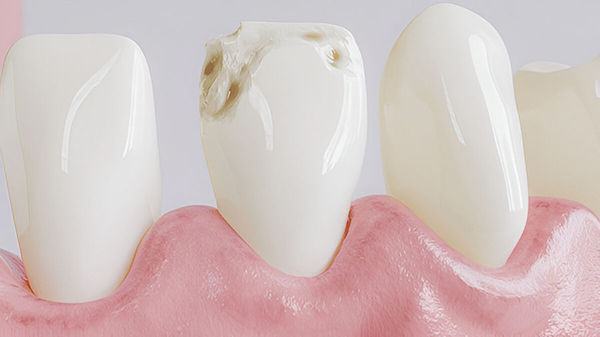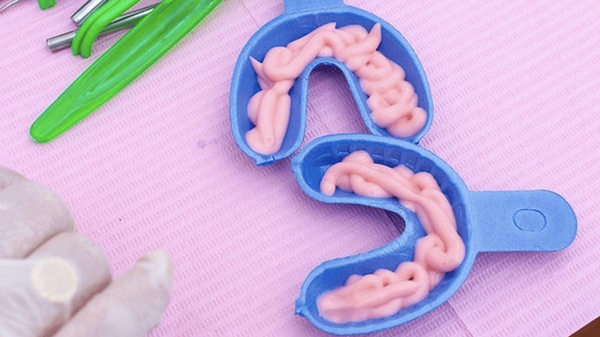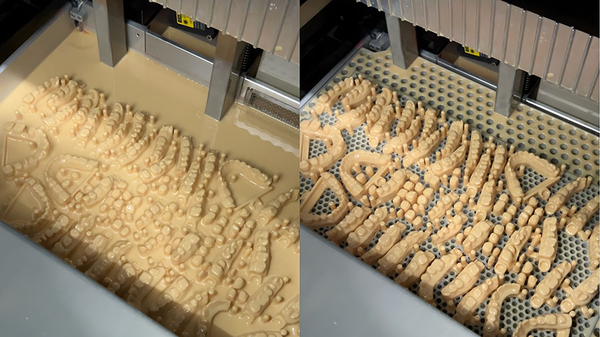Learn about the main types of orthodontic bracket materials, including stainless steel, ceramic, polymer, and titanium. Discover their advantages, disadvantages, and clinical applications to help choose the right material for effective orthodontic treatment.
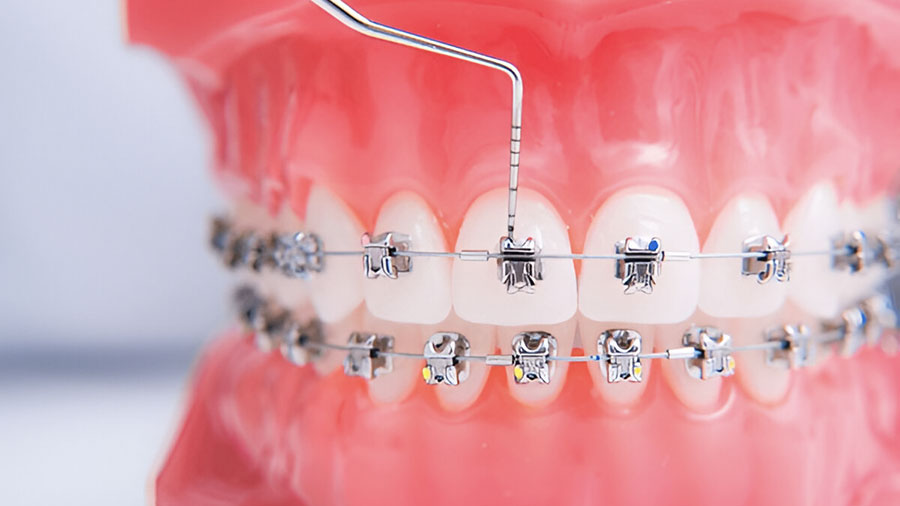
Table of contents [Show]
Orthodontic brackets play a pivotal role in aligning teeth and achieving successful orthodontic treatment outcomes. The choice of bracket material directly impacts treatment efficiency, patient satisfaction, and overall clinical performance. This article provides a detailed overview of the main categories of orthodontic bracket materials, their specific characteristics, and recent advancements in the field.
Main Categories of Bracket Materials
Stainless Steel Brackets
Stainless steel brackets are the most commonly used in orthodontics due to their excellent mechanical properties and cost-effectiveness.
Material Composition: Primarily austenitic types 303, 304, and 316L stainless steel.
Key Features:
High strength and durability.
Cost-effective and widely available.
Manufactured through methods like milling, casting, and metal injection molding.
Clinical Applications: Suitable for all types of orthodontic cases, offering reliable performance with minimal failure rates.
Drawbacks: Poor aesthetics and potential nickel allergy in sensitive patients.
Ceramic Brackets
Ceramic brackets are a popular choice for patients prioritizing aesthetics, as they blend with the natural tooth color.
Material Composition: Made from aluminum oxide (monocrystalline or polycrystalline).
Key Features:
Superior aesthetics and excellent color stability.
Chemical inertness, ensuring resistance to staining.
Higher brittleness compared to metal brackets, leading to more frequent failures.
Clinical Applications: Preferred for adult patients or those seeking discreet orthodontic solutions.
Drawbacks:
Higher failure rates compared to metal brackets (especially after 12 months of treatment).
Difficult debonding, with potential for enamel damage.
Polymer/Plastic Brackets
Polymer brackets are designed to offer aesthetic advantages at a lower cost compared to ceramic brackets.
Material Composition: Includes polycarbonate and polyoxymethylene materials.
Key Features:
Lightweight and aesthetic appearance.
More affordable than ceramic brackets.
Lower mechanical strength, making them less durable.
Susceptible to discoloration and wear over time.
Clinical Applications: Suitable for mild to moderate orthodontic cases where aesthetics are a priority.
Drawbacks: Limited lifespan and lower resistance to mechanical forces.
Titanium Brackets
Titanium brackets are an excellent option for patients with metal allergies or sensitivities.
Material Composition: Made from pure titanium or titanium alloys.
Key Features:
Outstanding biocompatibility and corrosion resistance.
Lower hardness (280-360 VHN) compared to stainless steel.
Lightweight and non-toxic.
Clinical Applications: Ideal for patients with nickel allergies or those requiring a hypoallergenic solution.
Drawbacks: Higher cost and limited availability compared to stainless steel brackets.
Comparative Analysis of Bracket Materials
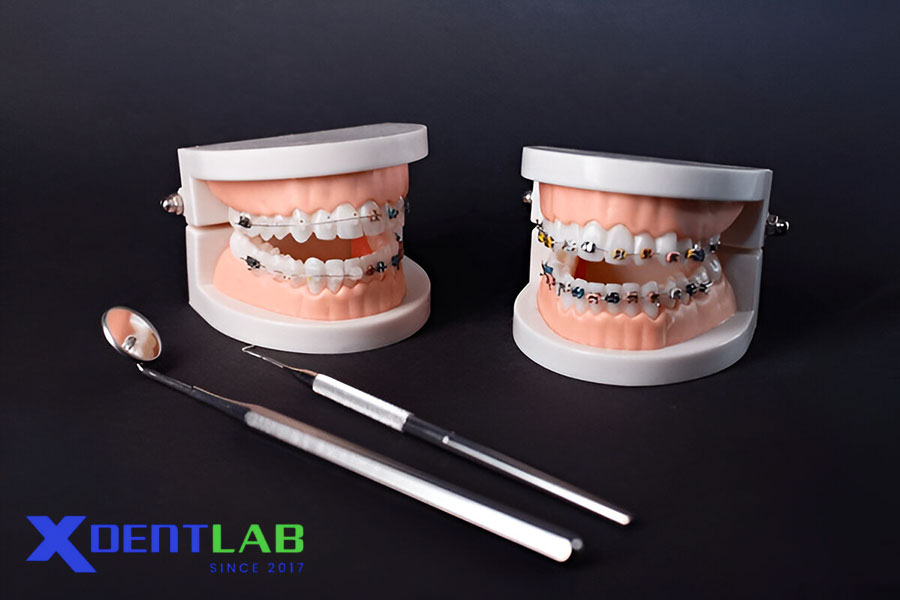
Mechanical Properties Comparison
Metal Brackets: Offer the highest mechanical strength and durability, making them ideal for long-term treatments.
Ceramic Brackets: Provide good strength but are more brittle, leading to higher failure rates.
Polymer Brackets: Exhibit the lowest mechanical properties but are adequate for less demanding clinical applications.
Sliding Resistance Study
Metal Brackets: Lowest friction coefficients, ensuring smoother tooth movement and shorter treatment durations.
Ceramic Brackets: Higher friction levels, which may slow down treatment progress.
Polymer Brackets: Intermediate friction levels, balancing aesthetics and functionality.
Clinical Performance
Failure Rates:
Metal brackets have the lowest failure rates.
Ceramic brackets show significantly higher failure rates after 12 months of treatment.
Treatment Duration: Failures in ceramic brackets can lead to treatment delays and inconvenience for patients.
Biofilm Formation: Different materials vary in bacterial adhesion, with implications for oral hygiene during treatment.
Material-Specific Characteristics
Stainless Steel Brackets
Advantages: High strength, cost-effective, reliable performance, and easy debonding.
Disadvantages: Poor aesthetics and potential for nickel allergies.
Best For: Most orthodontic cases, particularly posterior teeth where aesthetics are less critical.
Ceramic Brackets
Advantages: Excellent aesthetics, color stability, and chemical resistance.
Disadvantages: Higher brittleness, difficult debonding, and the potential for enamel damage.
Best For: Adult patients or those seeking aesthetic solutions for anterior teeth.
Polymer Brackets
Advantages: Affordable, good aesthetics, and easier debonding than ceramic brackets.
Disadvantages: Lower durability, discoloration, and susceptibility to wear.
Best For: Mild to moderate orthodontic cases with aesthetic concerns.
Titanium Brackets
Advantages: Biocompatibility, corrosion resistance, and suitability for allergic patients.
Disadvantages: Higher cost and limited availability.
Best For: Patients with metal allergies or sensitivities.
Recent Developments in Bracket Materials
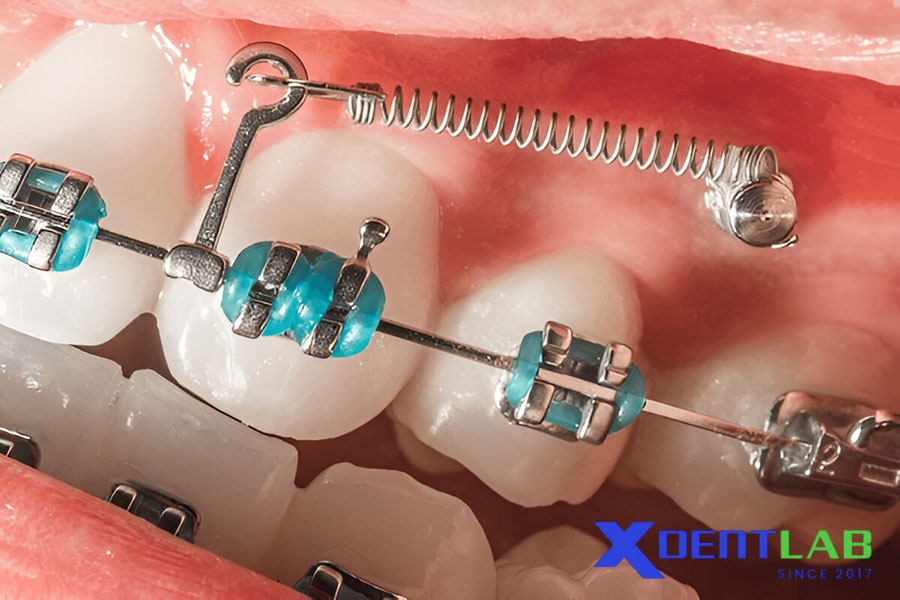
Biofilm Reduction Technologies
Silver Ion-Implanted Brackets: Reduce biofilm formation and improve oral hygiene.
Antimicrobial Coatings: Ongoing research is focused on enhancing bacterial resistance in brackets.
Hybrid Materials
Metal-Reinforced Ceramic Brackets: Combine the strength of metal with the aesthetics of ceramic.
Coated Metal Brackets: Offer enhanced aesthetics without compromising mechanical performance.
Clinical Considerations for Material Selection
Key Factors to Consider
Aesthetic Requirements: Patients prioritizing aesthetics may prefer ceramic or polymer brackets.
Treatment Complexity: Metal brackets are ideal for complex cases requiring high mechanical strength.
Patient Allergies: Titanium or ceramic brackets are recommended for patients with metal sensitivities.
Cost: Stainless steel brackets are the most cost-effective option.
Treatment Duration: Ceramic brackets may increase treatment time due to higher failure rates.
Evidence-Based Recommendations
Posterior Teeth: Stainless steel brackets are the most reliable option.
Anterior Teeth: Ceramic or high-quality polymer brackets are preferred for aesthetic-conscious patients.
Allergic Patients: Titanium or ceramic brackets are the best choices.
Informed Consent: Patients should be informed of the potential for higher failure rates with ceramic brackets.
Conclusion
The choice of orthodontic bracket material is critical to achieving optimal treatment outcomes. While stainless steel brackets remain the gold standard for reliability and cost-effectiveness, aesthetic alternatives like ceramic and polymer brackets continue to evolve, offering improved performance and patient satisfaction.
Titanium brackets provide a valuable solution for patients with allergies, and recent advancements in biofilm reduction technologies and hybrid materials further enhance the versatility of orthodontic brackets.
Ultimately, selecting the right bracket material requires careful consideration of the patient’s needs, treatment goals, and clinical requirements, ensuring a balance between aesthetics, functionality, and durability.
XDENT LAB is an expert in Lab-to-Lab Full Service from Vietnam, with the signature services of Removable & Implant, meeting U.S. market standards – approved by FDA & ISO. Founded in 2017, XDENT LAB has grown from local root to global reach, scaling with 2 factories and over 100 employees.. Our state-of-the-art technology, certified technicians, and commitment to compliance make us the trusted choice for dental practices looking to ensure quality and consistency in their products.
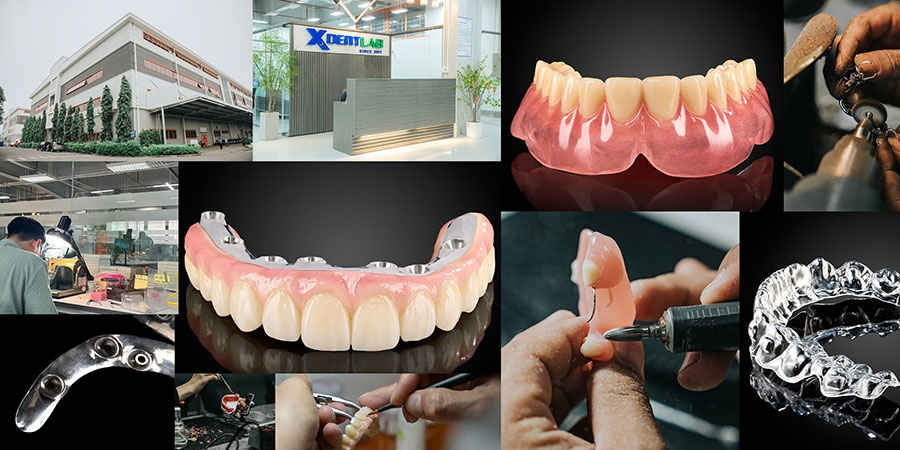
Our commitments are:
100% FDA-Approved Materials.
Large-Scale Manufacturing, high volume, remake rate < 1%.
2~3 days in lab (*digital file).
Your cost savings 30%.
Uninterrupted Manufacturing 365 days a year.
Contact us today to establish a strategy to reduce operating costs.
--------❃--------
Vietnam Dental Laboratory - XDENT LAB
🏢 Factory 1: 95/6 Tran Van Kieu Street, Binh Phu Ward, Ho Chi Minh City, Vietnam
🏢 Factory 2: Kizuna 3 Industrial Park, Can Giuoc Commune, Tay Ninh Province, Vietnam
☎ Hotline: 0919 796 718 📰 Get detailed pricing
Share this post:

